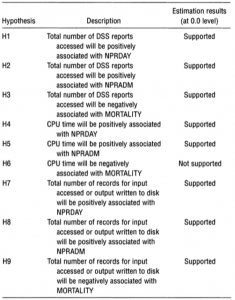Week 13_Devaraj and Kohli (2003)_Vicky Xu
Performance Impacts of Information Technology: Is Actual Usage the Missing Link?
In the last decade, many studies focused on the relationship between investment in information technology (IT) and its effect on organizational performance continues to interest academics and practitioners. Devaraj and Kohli (2003) assess the impact of the use of IT on organizational performance. The context of this study is the use of healthcare system to hospitals. The following figure shows the research model within the context of a hospital network of this study (Figure 1. p. 277):
Devaraj and Kohli (2003) collected the panel data across 8 hospitals of a health system network over 36 monthly time periods. The implemented technology is decision support systems (DSS) that help hospitals to identify clinical and financial, and quality improving opportunities. The usage of technology was captured from “a log created by a utility program to track user resource consumption (p. 278).”
Devaraj and Kohli (2003) use time-series analyses with fixed effects to estimate the proposed models. To check reverse causality, the authors performed the Granger Causality Test. The authors further conducted omitted variable test to address the omitted variable issue.
The following table summarizes the results of the study:
The results of this study provide general support for the proposition that the greater the actual usage of technology, the better the financial and quality performance of hospitals. Implications in this study include: (1). There is evidence that investments in technologies have positive payoffs when actual usage of the technology is considered. (2). This study presents evidence for the monetary impact and temporal impact due to the use of technology. (3). The IT payoff literature has documented mixed findings on the impact of IT investment on performance.




Leave a Reply
You must be logged in to post a comment.